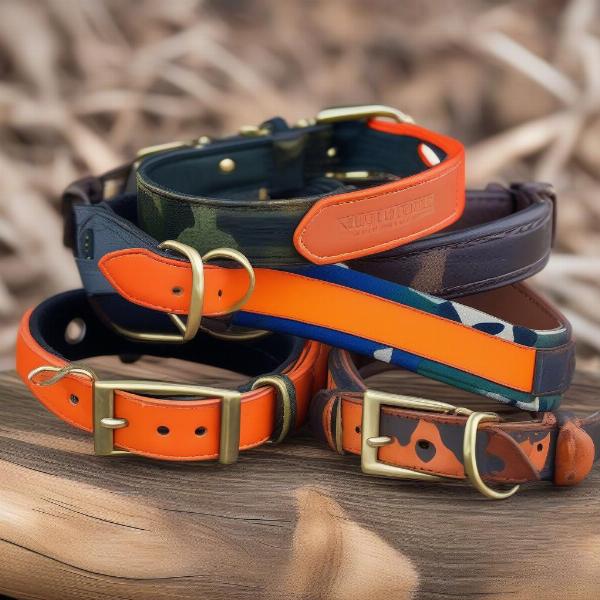Dog collars are an essential piece of equipment for any dog owner, serving as identification, a point of leash attachment, and even a fashion statement. For hunters, the right dog collar is even more critical, impacting both safety and performance in the field. This guide delves into the world of dog collars for hunting, exploring different types, features, and considerations to help you choose the perfect one for your hunting companion.
Types of Dog Collars for Hunting
Several types of dog collars cater to different hunting styles and dog breeds. Understanding the pros and cons of each can help you make an informed decision.
Tracking Collars
These collars utilize GPS technology to track your dog’s location, especially useful in dense terrain or when hunting elusive game. Modern tracking collars often integrate training features, like vibration and tone, allowing for remote communication and control.
E-Collars (Electronic Collars)
E-collars, sometimes controversial, provide a way to train and control your dog from a distance. They utilize varying levels of static stimulation, vibration, and tone to reinforce commands and deter unwanted behaviors, like chasing off-game. It’s crucial to use e-collars responsibly and humanely, focusing on positive reinforcement.
Traditional Hunting Collars
Typically made from durable materials like leather or nylon, traditional hunting collars offer a secure and comfortable fit. Many feature bright colors or reflective strips for enhanced visibility in low-light conditions. These collars are often preferred for close-working dogs where direct control and quick releases are essential.
Slip Collars/Choke Chains
While sometimes used for hunting, slip collars should be approached with caution. Their tightening action can pose a choking hazard if used improperly. Consult a professional dog trainer for guidance if you consider using this type of collar.
 Traditional Hunting Dog Collars for Enhanced Visibility and Control
Traditional Hunting Dog Collars for Enhanced Visibility and Control
Key Features to Consider
When selecting a dog collar for hunting, specific features can significantly impact its effectiveness and your dog’s comfort.
Durability and Material
Opt for robust materials like heavy-duty nylon or leather that can withstand harsh conditions and resist tearing. Consider waterproof and weather-resistant options for hunting in wet or muddy environments.
Fit and Adjustability
A properly fitted collar is crucial for both comfort and safety. Ensure the collar is snug but not restrictive, allowing for two fingers to fit comfortably between the collar and your dog’s neck.
Visibility
Bright colors and reflective elements enhance visibility, especially during low-light hunts, reducing the risk of accidental injuries.
Buckles and Fasteners
Quick-release buckles or other reliable fasteners allow for swift removal in emergencies.
GPS and Tracking Capabilities
If hunting in vast or challenging terrains, GPS tracking provides peace of mind, allowing you to locate your dog quickly if they become lost or separated.
Training Features
Integrated training features, such as vibration and tone, found in some tracking and e-collars, enhance communication and control.
Choosing the Right Collar for Your Hunting Dog
The ideal collar depends on your specific hunting style, dog breed, and individual dog’s temperament and training.
Consider your hunting environment.
Dense woods might necessitate a tracking collar, while open fields might be suitable for a traditional collar.
Factor in your dog’s breed and size.
Larger breeds require more robust collars than smaller breeds.
Assess your dog’s training level and behavior.
Well-trained dogs might only require a traditional collar, while dogs prone to distractions might benefit from an e-collar used responsibly and humanely.
Consult with a professional dog trainer.
A trainer can provide personalized recommendations based on your dog’s specific needs and your hunting style.
“A properly fitted and appropriate collar is essential for a safe and successful hunt,” says renowned dog trainer, Sarah Miller, CPDT-KA. “Consider your dog’s individual needs and your hunting style to make the best choice.”
Conclusion
Choosing the right dog collar for hunting is a crucial decision impacting both safety and performance in the field. By understanding the different types, features, and considerations, you can equip your hunting companion with the perfect collar to enhance their effectiveness and ensure their well-being. Remember to prioritize a proper fit, durability, and features that align with your specific hunting needs.
FAQ
- What is the best type of collar for a hunting dog? There is no single “best” collar, as it depends on various factors like your hunting style, dog breed, and training level. Consider the options discussed above and consult with a professional trainer.
- Are e-collars safe for hunting dogs? When used responsibly and humanely, e-collars can be a valuable training tool. However, improper use can lead to physical and psychological harm.
- How should a hunting dog’s collar fit? The collar should be snug enough to prevent slipping off but loose enough to allow two fingers to fit comfortably between the collar and the dog’s neck.
- What features should I look for in a hunting dog collar? Durability, visibility, secure fasteners, and GPS tracking capabilities are important features to consider.
- Where can I buy dog collars for hunting? Specialty pet stores, online retailers, and hunting supply stores often carry a variety of hunting dog collars.
ILM Dog is a leading international pet website dedicated to providing expert advice and resources on all aspects of dog care and ownership. We offer valuable information on dog breeds, health and wellness, training, nutrition, and much more. Our expertise in products and accessories helps you find the perfect gear for your furry friend. For any inquiries, contact us at [email protected] or call us at +44 20-3965-8624. Visit ILM Dog for more expert advice.